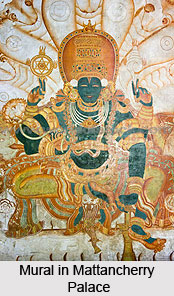 Murals in Mattancherry Palace are known as the masterpieces of art which adds to the stateliness of this majestic palace. Mattancherry Palace, situated in Kochi city of Kerala, is regarded amongst the architectural wonders of the country. Apart from its magnificent structure; it is also the home of a variety of gorgeous artefacts which displays the erstwhile splendour of the palace. Among all the antiquities, the murals have acquired a significant position amongst the best traditions of Hindu temple art. These are characterized by their stylized, decorative as well as religious nature and are the testaments of glorious Indian art. The rich and vibrant colours laid with tempera technique on the murals reveal an enchanting aura of its own.
Murals in Mattancherry Palace are known as the masterpieces of art which adds to the stateliness of this majestic palace. Mattancherry Palace, situated in Kochi city of Kerala, is regarded amongst the architectural wonders of the country. Apart from its magnificent structure; it is also the home of a variety of gorgeous artefacts which displays the erstwhile splendour of the palace. Among all the antiquities, the murals have acquired a significant position amongst the best traditions of Hindu temple art. These are characterized by their stylized, decorative as well as religious nature and are the testaments of glorious Indian art. The rich and vibrant colours laid with tempera technique on the murals reveal an enchanting aura of its own.
Palliyara of the palace, also known as the king`s bedchamber, located at the left of the entrance and at the southwest corner of the palace is famed for its low wooden ceiling which is richly embellished with 48 paintings. These murals beautifully depict the Ramayana, starting from the sacrifice of king Dasaratha to the return of Sita from the confinement in Lanka. These painting have been estimated to be the most ancient in the palace and dates back to about 16th century. In this section, the last five scenes belong to the Krishna Lila. These beautiful paintings are the manifestation of noteworthy artistic concepts of Veera Kerala Verma, who was the ruler of Kerala from 1809 to 1828.
The rooms in the upper staircase were the Dutch addition to the palace and also showcase some of magnificent murals. This section of murals comprises illustrations such as Shiva and Parvati seated with Ardhanariswara and other goddess, sleeping Vishnu (Ananthasayanamurti), Lakshmi seated on the lotus, Krishna lifting Mount Govardhana and the coronation of Rama. Opposite to the coronation hall there is a staircase room, also known as Kovinithalam which descends to a lower storey. The room houses four paintings out of which one is incomplete and the others are of Vishnu, Shiva and Devi. Another room in the palace has depictions of the scenes from Kumarasambhava and other literary works of the renowned poet Kalidasa. These paintings date back to 18th century.



















